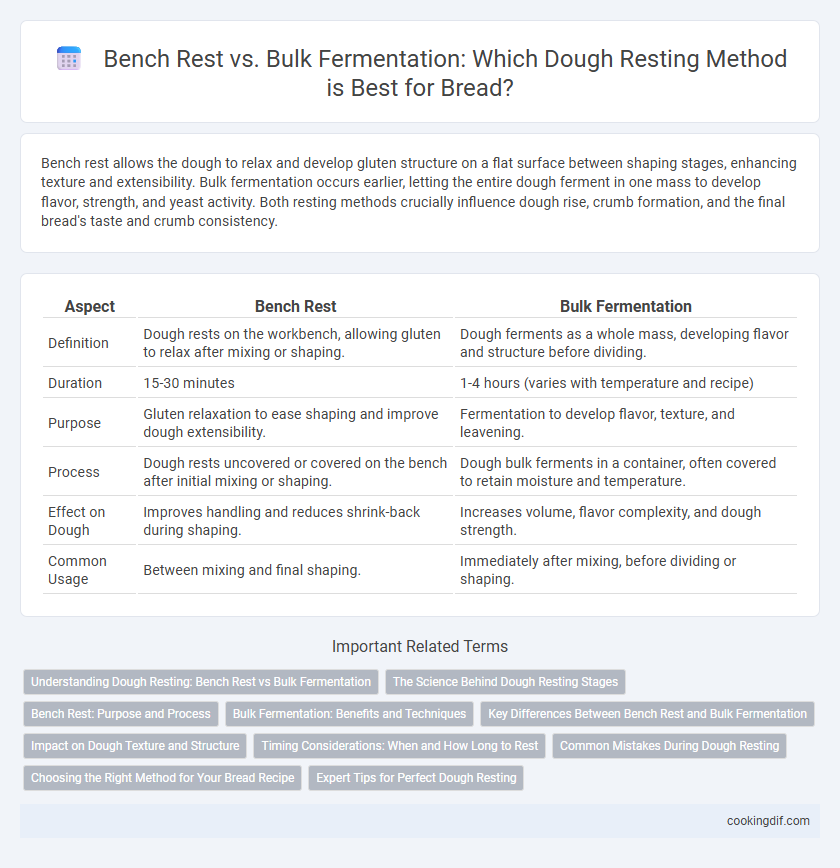Bench rest allows the dough to relax and develop gluten structure on a flat surface between shaping stages, enhancing texture and extensibility. Bulk fermentation occurs earlier, letting the entire dough ferment in one mass to develop flavor, strength, and yeast activity. Both resting methods crucially influence dough rise, crumb formation, and the final bread's taste and crumb consistency.
Table of Comparison
| Aspect | Bench Rest | Bulk Fermentation |
|---|---|---|
| Definition | Dough rests on the workbench, allowing gluten to relax after mixing or shaping. | Dough ferments as a whole mass, developing flavor and structure before dividing. |
| Duration | 15-30 minutes | 1-4 hours (varies with temperature and recipe) |
| Purpose | Gluten relaxation to ease shaping and improve dough extensibility. | Fermentation to develop flavor, texture, and leavening. |
| Process | Dough rests uncovered or covered on the bench after initial mixing or shaping. | Dough bulk ferments in a container, often covered to retain moisture and temperature. |
| Effect on Dough | Improves handling and reduces shrink-back during shaping. | Increases volume, flavor complexity, and dough strength. |
| Common Usage | Between mixing and final shaping. | Immediately after mixing, before dividing or shaping. |
Understanding Dough Resting: Bench Rest vs Bulk Fermentation
Bench rest refers to the period when individual dough portions rest on the work surface, allowing gluten to relax and making shaping easier, typically lasting 15 to 30 minutes. Bulk fermentation, on the other hand, involves allowing the entire dough mass to ferment before dividing, promoting flavor development and gluten strength over several hours. Mastering the balance between bench rest and bulk fermentation is essential for achieving an open crumb structure and optimal dough elasticity in artisan bread baking.
The Science Behind Dough Resting Stages
Bench rest allows gluten to relax after kneading, promoting easier shaping and improved dough elasticity. Bulk fermentation fosters yeast activity and flavor complexity through extended enzymatic reactions and gas production in a warm environment. Both stages are crucial for optimal crumb structure and bread rise, balancing gluten development and fermentation time.
Bench Rest: Purpose and Process
Bench rest allows dough to relax gluten strands, making it easier to shape and reducing shrinkage during baking. This resting phase occurs after initial mixing and before final proofing, typically lasting 20 to 30 minutes at room temperature. Proper bench rest improves dough extensibility, resulting in a more open crumb structure and enhanced oven spring.
Bulk Fermentation: Benefits and Techniques
Bulk fermentation enhances dough flavor complexity and texture by allowing yeast and bacteria to develop naturally over several hours, resulting in improved crumb structure and crust quality. Techniques such as controlling temperature, using a tightly covered container, and performing gentle folds during this stage optimize gas retention and gluten strength. Emphasizing bulk fermentation fosters dough extensibility and promotes better rise, leading to artisan-quality bread with richer taste profiles.
Key Differences Between Bench Rest and Bulk Fermentation
Bench rest and bulk fermentation are two essential stages in bread dough development, each serving distinct purposes. Bulk fermentation occurs immediately after mixing, allowing yeast to ferment the entire mass of dough, producing carbon dioxide and developing flavor and gluten structure over several hours. Bench rest follows bulk fermentation, involving dividing and shaping the dough, then resting it to relax gluten, making it easier to shape before final proofing and baking.
Impact on Dough Texture and Structure
Bench rest enhances dough elasticity by allowing partial gluten relaxation and yeast activation on a flat surface, resulting in a more extensible and airy crumb. Bulk fermentation promotes extensive yeast activity and gluten development within the entire dough mass, improving gas retention and creating a more open and structured crumb. The choice between bench rest and bulk fermentation directly influences dough texture, with bulk fermentation typically producing a chewier texture and bench rest yielding a softer dough.
Timing Considerations: When and How Long to Rest
Bench rest typically lasts 15 to 30 minutes, allowing the dough to relax after shaping, which improves extensibility and eases handling. Bulk fermentation usually takes 1 to 3 hours, depending on yeast activity, ambient temperature, and dough hydration, enabling gluten development and flavor enhancement. Proper timing in both phases is crucial to achieve optimal dough structure and overall bread quality.
Common Mistakes During Dough Resting
Bench rest and bulk fermentation are critical stages in dough resting that directly impact bread texture and flavor development, yet common mistakes often arise from mismanaging these periods. Allowing dough to underproof during bench rest can lead to tight crumb structure, while excessively long bulk fermentation causes overproofing, resulting in sour flavors and poor oven spring. Precise timing and temperature control are essential to optimize gluten relaxation and yeast activity, preventing dense loaves and uneven fermentation.
Choosing the Right Method for Your Bread Recipe
Bench rest provides a shorter, controlled resting period allowing the dough to relax and become easier to shape, ideal for lean breads like baguettes or sourdough. Bulk fermentation involves a longer, primary rise that develops flavor and gluten structure, suitable for enriched doughs or artisanal breads requiring complex fermentation. Selecting the right method depends on the desired bread texture, crumb development, and recipe complexity to achieve optimal results.
Expert Tips for Perfect Dough Resting
Bench rest allows dough to relax and hydrate after initial mixing, enhancing gluten development and improving dough extensibility. Bulk fermentation promotes yeast activity and flavor complexity by resting the entire dough mass before shaping, crucial for optimal crumb structure. Expert bakers recommend balancing both: a short bench rest to ease shaping followed by a precise bulk fermentation to achieve perfect dough texture and rise.
Bench Rest vs Bulk Fermentation for dough resting Infographic

 cookingdif.com
cookingdif.com